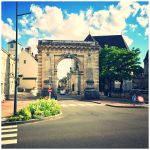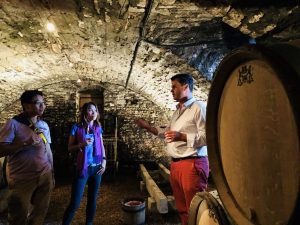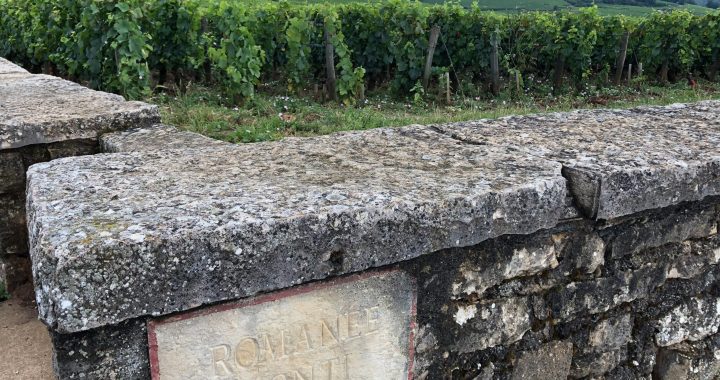Burgundy is a wine region 3.5+ hours drive south west of Paris, with the wine regions being famous for their elegant Pinot Noir and Chardonnay. Every wine region and wine maker will benchmark their Pinot Noir and Chardonnay with a Grand Cru produced from Burgundy. Historically there are many reasons for this exceptional statue that Burgundy wines have achieved, from the unique terroir to the innovative wine making techniques; where to this day wine makers across the world will take note of and apply the wine making techniques that originated (and are still evolving) from Burgundy wine makers. Another key reason related to the terroir that provides Burgundy an edge is the ability to grow one of the most fickle grape varieties, Pinot Noir; however with global warming and other factors, this has also added extra stress and challengers, but also pushing the Burgundy wine makers to further innovate to ensure the future of Burgundy wines will be still be the envy of the world!
The Burgundy AOC (Bourgogne AOC formally know in French) is a regional appellation made up of four sub-regions (each of which are are also regional appellation but with more restrictive rules compared to Bourgogne AOC), from north to south they are Chablis, Côte d'Or, Côte Chalonnaise and Mâconnais. The most famous of the four regions is Côte d'Or where a majority of the most expensive wines are produced; which is further sub-divided into two from north to south the are Côte de Nuits and Côte de Beaune.
From an wine law perspective,  Burgundy has the most number of AOC than any other french wine region, it is at times very confusing and complex as one AOC may contain many AOC’s, to determine which AOC is to be placed on the label, the general rule is that the strictest AOC rules that the wine has followed is used. The following are only some examples of Burgundy labels from most restrictive (highest quality) to least restrictive (lowest quality), for a full explanation it is hard as some of the AOC change (such as the number of Premier Cru) but some AOC do not change (such as Grand Cru)1
Burgundy has the most number of AOC than any other french wine region, it is at times very confusing and complex as one AOC may contain many AOC’s, to determine which AOC is to be placed on the label, the general rule is that the strictest AOC rules that the wine has followed is used. The following are only some examples of Burgundy labels from most restrictive (highest quality) to least restrictive (lowest quality), for a full explanation it is hard as some of the AOC change (such as the number of Premier Cru) but some AOC do not change (such as Grand Cru)1
- Grand Cru, Clos Vougeot, Appellation Clos Vougeot Contrôlée - When the term Grand Cru is present on a Burgundy wine label, it denotes that it comes from one of 33 vineyards (or Climats) that have been designated with the highest vineyard classification; these represent only 1% to 2% of the entire Burgundy AOC. Each Grand Cru has it’s own AOC (in this example the vineyard is Clos Vougeot hence the AOC is Appellation Clos Vougeot Contrôlée); it must be noted that the term “Grand Cru” is NOT always shown on the label as the name of the vineyard (climats) shown will automatically denote that the wine is under the specified Grand Cru’s AOC
- Vosne-Romanée Les Suchots, Appellation Vosne-Romanée 1er Cru Contrôlée - When the term 1er Cru (or Premier Cur) is presented along with a village name (in this example is Vosne-Romanée) and usually the name of the vineyard (climats) (in this example Les Suchots) on a Burgundy wine label, it denotes that it comes from one of the 600+ vineyards (or Climats) that have been designed as an Premier Cru; this represents around 12% of the entire Burgundy AOC
- Appellation Chambolle-Musigny Contrôlée - When the AOC also states a village name (one of 44) on a Burgundy wine label, it denotes that the wine is from the one village (commune), as each village will have it’s own characteristics. An wine maker can blend grapes from an Grand Cru vineyard with an Premier Cru vineyard in the same village (commune) but it will only be classified as an village AOC
- Appellation Bourgogne Contrôlée or Appellation Bourgogne Côte d'Or Contrôlée - These are region AOC within the Bourgogne (Burgundy) region, if all the grapes used to make the wine are within one of the four sub-regions then the sub-region can be used in the AOC
The historic town of Beaune  is in the middle of Côte de Beaune and extending in a narrow strip northward for 50km to the city of Dijon is Côte de Nuits; this 50km narrow strip is where I have focused my Burgundy wine exploration.
is in the middle of Côte de Beaune and extending in a narrow strip northward for 50km to the city of Dijon is Côte de Nuits; this 50km narrow strip is where I have focused my Burgundy wine exploration.
- Climate: The climate in Burgundy is divided into two distinct classification, in the more northern part of Chablis it is Cool Continental whilst the remaining areas is Moderate Continental.
- Grapes: The Burgundy AOC allows the use of Pinot Noir and Gamay (red) and Chardonnay and Aligoté (white) grapes. However Pinot Noir and Chardonnay is what Burgundy wine is known for, the ancestral home of these grape varieties!
- Wine Style: Pinot Noir are elegant with soft tannins with strawberry fruits and when ages have all the tertiary characteristics of earthiness, whilst the Chardonnay are full body and when aged have all the tertiary characteristics of honey. The traditional wine making style of both are to perform maturation in french oak, and for the Chardonnay Burgundy pioneered a lot of the wine making techniques such as “Sue Lie” (on lees - dead yeast, fermentation) and use of malolactic fermentation (MLF) to add complexity and enhance the final wine.
- Size and Yield: Approximately 30,000 hectares under vine, the yield varies depending on the AOC classification but on average 50 hectolitres per hectare2 with as low yield as under 40 hectolitres per hectare for Grand Cru reds
Winery
Burgundy is a small wine region compared to a lot of wine regions (Bordeaux has over 100,000 hectares under vine, 3 to 4 times the size of Burgundy, Loire Valley has over 55,000 hectares under vine, almost double the size of Burgundy); this means that a lot of the wine has been “pre-allocated” / “pre-sold” by the wine maker so wine tasting and wine tours are rare (except for the larger ones). I have been lucky enough to join a number of private wine tours where a majority of the time we were hosted by the wine maker and had a wine tasting, these are usually arranged through wine merchants or wine distributors that friends and colleagues have strong connections to; the following are some winery that I have had the privilege to visit and what to expect;
- Domaine Romanée Conti (Vosne-Romanée) (map) - To be clear, I have not had the privilege to join a wine tour at DRC; actually not many people in the world has had this privilege! I have had the opportunity to enjoy some of their wine at various restaurants in Burgundy, which is at times a quarter of the price to buy in Hong Kong (if you can buy it!). If you have not heard of DRC, then all you need to know is that they make the most expensive bottle of wine which is called Romanée Conti which is an Grand Cru Monopole (the whole climat has only one owner so only they can have the wine from that climat)
- Domaine Lamarche - I have had the
 pleasure to meet with the owner and wine maker a few times, she distributes her wines through Pearl of Burgundy and you can purchase and / or join their events; however she does not do private tours or tastings, unless you can arrange through Pearl of Burgundy. She has a lot of very good Grand Cru climats, one of which is La Grand Rue, which is also an Grand Cru monopole and it is right next to the Romanée Conti climat
pleasure to meet with the owner and wine maker a few times, she distributes her wines through Pearl of Burgundy and you can purchase and / or join their events; however she does not do private tours or tastings, unless you can arrange through Pearl of Burgundy. She has a lot of very good Grand Cru climats, one of which is La Grand Rue, which is also an Grand Cru monopole and it is right next to the Romanée Conti climat - Domaine du Comte Liger-Belair (Vosne-Romanée) (map) -
 Very similar to Domaine Lamarche, getting a private tour and wine tasting need to go through an wine distributor; he also has a climat that is right next the Romanée Conti climat called La Romanée and it is also an Grand Cru monopole
Very similar to Domaine Lamarche, getting a private tour and wine tasting need to go through an wine distributor; he also has a climat that is right next the Romanée Conti climat called La Romanée and it is also an Grand Cru monopole - Domaine Faiveley (Nuits-Saint-George) (map) - A larger winery in Burgundy that offers pre-booking wine tours on their website, they have a large range or wines from Grand Cru to Bourgogne AOC; well worth to experience the wine tours!
- Domaine Prieure Roch (Nuits-Saint-George) - Previously they had a small “wine bar” which doubled as a cellar door, but it looks like that only their wines are available at the restaurant Premnord Restaurant (map)
- Louis Jadot (Beaune) (map) - Not my favourite wine maker, they are an Maison (they purchase the fruit from grape growers to make their wine, they don’t own any vineyards - or very little); but a big wine maker in Burgundy and quite commercial hence they do offer wine tours and wine tastings on their websites, you can have a try, when I went the best wine we had to taste was an Premier Cru only
The question that arises is “why visit Burgundy” if you cannot visit any of the winery; firstly you can try to book some wine tours and wine tastings at the larger winery, but been in Burgundy and seeing the vineyards yourself and experiencing the micro-climate at the vineyard that has the fruit that makes the most expensive wine in the world is an experience on itself!
Another reason to visit Burgundy is that you can have the wines in the local restaurants at a very reasonable price; so worth to try different restaurants and check-out their wine lists and opening bottles of Burgundy that you will not be able to try (or afford) back home!
There are also many bottle shops (cavas) in the Burgundy region, go and have a look; there are some that purchase and resell wines from private collectors; usually the private collectors will have their own cellar where the wines are kept in good condition with the exception of the wines label which at times is damaged.
Accommodation
There are various types of accommodation from hotels to home stays (bed and breakfast), in general the hosts at the B&B are very good, and they provide large clean accommodation, usually detached or separated from the hosts living quarters so it is very private; however the drawback is that the hosts usually only speak French and English is very limited.
- ibis Styles Beaune Centre Hotel (Beaune) (map) - An international brand chain hotel in the heart of Beaune, it is very simple hotel but location wise is very good! They have their own private underground car park.
Restaurant
The restaurants in the Burgundy region all serve Burgundy wines, and usually at a very reasonable price (sometimes a quarter of what you will pay retail for in Hong Kong!); so worth to go and eat out when in Burgundy, here are some restaurants I have tried and have a very good and reasonably priced Burgundy wines!
- Ma Cuisine (Beaune) (map) - Right in the middle of Beaune, heart of Burgundy country! Great food, also recommended in the Michelin Guide and with it a great wine list; very long so you will need to study it to pick a good value wine
- Le comptoir des Tontons (Beaune) (map) - Also in Beaune, great local food with a great wine list
- Maison Lameloise (15min from Beaune) (map) - A 3 Michelin Star restaurant that I have been multiple times, great food, great service and great atmosphere; highly recommended!
Additional Information
So highly recommended for you to just drive around the Burgundy region, look for the famous climats (such as all the Grand Cru’s like Clos Vougeot, Montrachet, La Tâche, Romanée Conti etc); you will be amazed at how close you can get to some of these vineyards! They are all centered around small little villages such as Puligny-Montrachet, Vosne-Romanée, Vougeot, Chambolle-Musigny, so explore and look for restaurants and cavas!
References
- https://www.bourgogne-wines.com/wine-and-terroir/decoding-the-aocs/bourgogne-wines-decoding-the-aocs,2467,9263.html
- https://www.bourgogne-wines.com/ (yield)


